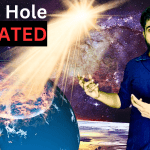- What is the Big Crunch Theory and How Does it Work?
- The Origins of the Big Crunch Theory: A Brief History
- The Evidence Supporting the Big Crunch Theory
- The Potential Implications of the Big Crunch Theory for Our Universe
- Exploring the Possibility of a Big Crunch and its Impact on Cosmology
- The Big Crunch vs. the Big Freeze: Comparing Two Theories of the Universe’s Fate
- Could the Big Crunch Theory Help Explain Dark Energy?
- The Role of Black Holes in the Big Crunch Theory
- Debating the Validity of the Big Crunch Theory
- What Happens to Life and Civilization During a Big Crunch?
- Conclusion.
What is the Big Crunch Theory and How Does it Work
The Big Crunch Theory is a cosmological model that proposes the universe will eventually collapse in on itself. This collapse will result in a state of extreme density and temperature known as the “big crunch.” The Big Crunch Theory is one of several possible fates for the universe, which also include the Big Freeze and the Big Rip.
According to the Big Crunch Theory, the universe is expanding, but this expansion is gradually slowing down due to the gravitational pull of all the matter in the universe. Eventually, this deceleration will cause the expansion to reverse, and the universe will begin to contract.
As the universe contracts, it will become more and more dense, and the temperature will increase. This will cause all matter in the universe to come together into a single point, known as a singularity. The singularity will be incredibly hot and dense, and it is thought that the laws of physics as we know them will break down.
The Big Crunch Theory has significant implications for the fate of the universe. If the universe does collapse in on itself, it will end in a state of high density and temperature, which some scientists believe could lead to the creation of a new universe in a “big bounce” scenario.
While the Big Crunch Theory has some evidence to support it, it is still a subject of debate among cosmologists. Some argue that the observed acceleration of the universe’s expansion suggests that the Big Crunch may not occur, and that the universe will instead continue to expand forever.
Regardless of its ultimate validity, the Big Crunch Theory remains an important area of study in cosmology. By understanding the potential fate of the universe, scientists can gain valuable insights into the nature of the cosmos and the laws that govern it.
The Origins of the Big Crunch Theory: A Brief History
The Big Crunch Theory is a fascinating idea that proposes the universe will eventually collapse in on itself, resulting in a state of extreme density and temperature known as the “big crunch.” But where did this theory come from, and how did it develop over time? In this blog, we’ll take a brief look at the origins of the Big Crunch Theory and its evolution throughout history.
The Big Crunch Theory can be traced back to the work of physicist Richard Tolman in the 1930s. Tolman was one of the first scientists to suggest that the universe was expanding, and he also proposed that this expansion would eventually slow down and reverse due to the gravitational pull of all the matter in the universe.
Tolman’s ideas were further developed by physicist George Gamow in the 1940s. Gamow was interested in the early universe and how it had evolved over time, and he used the Big Bang Theory as a framework for his work. Gamow suggested that the universe would eventually collapse in on itself due to the gravitational pull of all the matter in the universe.
In the decades that followed, other scientists built on the work of Tolman and Gamow to refine and develop the Big Crunch Theory. In the 1960s and 1970s, physicist Stephen Hawking made significant contributions to the theory, including the suggestion that black holes could play a crucial role in the eventual collapse of the universe.
Despite its evolution over time, the Big Crunch Theory remains a subject of debate among cosmologists. Some argue that the observed acceleration of the universe’s expansion suggests that the Big Crunch may not occur, and that the universe will instead continue to expand forever.
Regardless of its ultimate fate, the Big Crunch Theory has played an important role in the history of cosmology. By exploring the potential fate of the universe, scientists have gained valuable insights into the nature of the cosmos and the laws that govern it. As our understanding of the universe continues to evolve, it is likely that the Big Crunch Theory will continue to be a subject of fascination and exploration for generations to come.
The Evidence Supporting the Big Crunch Theory
The Big Crunch Theory is a fascinating concept that proposes that the universe will eventually collapse in on itself, resulting in a state of extreme density and temperature. While the theory is still a subject of debate among scientists, there is a growing body of evidence that supports the possibility of a Big Crunch. In this blog, we’ll explore some of the evidence that supports the Big Crunch Theory.
One of the key pieces of evidence for the Big Crunch Theory is the observed deceleration of the universe’s expansion. In the early 20th century, astronomers observed that distant galaxies were moving away from us at an accelerating rate. This led to the development of the Big Freeze Theory, which suggests that the universe will continue to expand forever, eventually resulting in a cold, dark, and lifeless cosmos. However, more recent observations have suggested that the rate of expansion may be slowing down, which supports the possibility of a Big Crunch.
Another piece of evidence for the Big Crunch Theory comes from the observation of galaxy clusters. Scientists have found that some galaxy clusters are moving towards each other, suggesting that the gravitational forces between them are stronger than the expansion of the universe. If this trend continues, it could eventually lead to the collapse of the entire universe.
Additionally, some scientists have suggested that the distribution of matter in the universe supports the Big Crunch Theory. According to the theory, the universe will eventually collapse in on itself due to the gravitational pull of all the matter in the cosmos. If this is true, then the distribution of matter in the universe should be dense enough to eventually cause the collapse.
Despite these pieces of evidence, the Big Crunch Theory remains a subject of debate among cosmologists. Some argue that the observed acceleration of the universe’s expansion suggests that the Big Crunch may not occur, and that the universe will instead continue to expand forever. However, as our understanding of the universe continues to evolve, it is likely that scientists will continue to explore the evidence for and against the Big Crunch Theory, and seek to better understand the ultimate fate of our cosmos.
The Potential Implications of the Big Crunch Theory for Our Universe
The Big Crunch Theory is a concept that proposes that the universe will eventually collapse in on itself, resulting in a state of extreme density and temperature. While the theory is still a subject of debate among scientists, its potential implications for our universe are intriguing to consider. In this blog, we’ll explore some of the possible implications of the Big Crunch Theory.
One potential implication of the Big Crunch Theory is that it could provide an explanation for the ultimate fate of the universe. If the theory is correct, the universe will eventually collapse in on itself, leading to a state of extreme density and temperature. This could result in a massive explosion, leading to a new cycle of expansion and contraction. This cyclical model of the universe has been proposed by some scientists and could provide a new framework for understanding the evolution of the cosmos.
Another potential implication of the Big Crunch Theory is that it could help us to better understand the nature of dark matter and dark energy. These two mysterious substances are thought to make up the majority of the mass and energy in the universe, yet we still know very little about them. If the Big Crunch Theory is correct, it could provide clues about how dark matter and dark energy behave during the collapse of the universe.
Additionally, the Big Crunch Theory could have profound implications for the search for extraterrestrial life. If the theory is correct, it could mean that life in the universe is ultimately doomed. However, it could also mean that there are other civilizations out there that have already gone through a cycle of expansion and contraction, and that we may be able to learn from their experiences.
Finally, the Big Crunch Theory could have important implications for our understanding of the laws of physics. If the theory is correct, it would mean that the laws of physics that govern the universe are cyclical, repeating themselves in each cycle of expansion and contraction. This could help us to better understand the fundamental nature of the cosmos and could lead to new insights and discoveries in the field of physics.
In conclusion, the Big Crunch Theory is a fascinating concept that could have important implications for our understanding of the universe, the laws of physics, and the search for extraterrestrial life. While the theory is still a subject of debate among scientists, its potential impact is certainly worth exploring further.
Exploring the Possibility of a Big Crunch and its Impact on Cosmology
The Big Crunch Theory is a concept that has captivated the minds of cosmologists for decades. While the theory is still not widely accepted, its potential impact on cosmology is significant. In this blog, we’ll explore the possibility of a Big Crunch and its impact on the field of cosmology.
The Big Crunch Theory proposes that the universe will eventually collapse in on itself due to the gravitational pull of all the matter in the cosmos. This collapse would result in a state of extreme density and temperature, leading to a massive explosion that would create a new cycle of expansion and contraction. While the theory is still a subject of debate among scientists, it could have profound implications for our understanding of the evolution of the universe.
If the Big Crunch Theory is correct, it would mean that the universe is ultimately cyclical, with each cycle of expansion and contraction lasting billions of years. This would fundamentally change our understanding of the evolution of the cosmos and would require us to rethink many of our current cosmological models.
Furthermore, the Big Crunch Theory could have important implications for our understanding of dark matter and dark energy. These two mysterious substances are thought to make up the majority of the mass and energy in the universe, yet we still know very little about them. If the Big Crunch Theory is correct, it could provide new insights into how dark matter and dark energy behave during the collapse and subsequent explosion of the universe.
Additionally, the Big Crunch Theory could have important implications for the search for extraterrestrial life. If the theory is correct, it would mean that the ultimate fate of life in the universe is ultimately cyclical. This could lead to new ideas about how life might evolve and adapt during each cycle of expansion and contraction.
Finally, the Big Crunch Theory could have a significant impact on the future of cosmology as a field. If the theory is correct, it would mean that our current understanding of the universe is incomplete and that there is much more to learn about the fundamental nature of the cosmos. This could lead to new avenues of research and could result in major discoveries in the field of cosmology.
The Big Crunch vs. the Big Freeze: Comparing Two Theories of the Universe’s Fate
For centuries, scientists and philosophers have been grappling with the ultimate fate of the universe. Two popular theories that attempt to answer this question are the Big Crunch Theory and the Big Freeze Theory. In this blog, we’ll compare and contrast these two theories and explore their potential implications for the future of the universe.
The Big Crunch Theory proposes that the universe will eventually collapse in on itself due to the gravitational pull of all the matter in the cosmos. This collapse would result in a state of extreme density and temperature, leading to a massive explosion that would create a new cycle of expansion and contraction. The Big Freeze Theory, on the other hand, proposes that the universe will continue to expand indefinitely, leading to a state of maximum entropy and a complete cessation of all activity.
One of the key differences between these two theories is their view of the universe’s energy. The Big Crunch Theory assumes that the universe has a finite amount of energy, while the Big Freeze Theory assumes that the universe has an infinite amount of energy. This fundamental difference in assumptions leads to very different predictions about the universe’s future.
Another difference between these two theories is their view of the universe’s lifespan. The Big Crunch Theory suggests that the universe is ultimately cyclical, with each cycle of expansion and contraction lasting billions of years. The Big Freeze Theory, on the other hand, suggests that the universe is ultimately finite, with a finite lifespan that will eventually lead to its demise.
Despite these differences, both the Big Crunch Theory and the Big Freeze Theory have important implications for the future of the universe. If the Big Crunch Theory is correct, it would mean that the ultimate fate of the universe is ultimately cyclical, with each cycle of expansion and contraction leading to new opportunities for life and evolution. If the Big Freeze Theory is correct, it would mean that the universe’s future is ultimately bleak, with a cold and lifeless cosmos that is devoid of any activity.
In conclusion, the Big Crunch Theory and the Big Freeze Theory are two competing theories that attempt to answer the ultimate question of the universe’s fate. While these theories differ in their assumptions and predictions, they both have important implications for our understanding of the cosmos. As scientists continue to explore the evidence for and against these two theories, it is clear that our understanding of the universe’s fate will continue to evolve and change.
Could the Big Crunch Theory Help Explain Dark Energy?
For decades, astronomers have been trying to solve the mystery of dark energy, a force that is driving the accelerated expansion of the universe. While many theories have been proposed to explain this phenomenon, none have been able to fully account for it. However, recent research has suggested that the Big Crunch Theory could hold the key to understanding dark energy.
The Big Crunch Theory suggests that the universe will eventually collapse in on itself due to the gravitational pull of all the matter in the cosmos. This collapse would result in a state of extreme density and temperature, leading to a massive explosion that would create a new cycle of expansion and contraction. However, the Big Crunch Theory also suggests that the universe is filled with a type of matter known as dark matter, which has a gravitational pull that counteracts the effects of dark energy.
Dark matter is a type of matter that does not interact with light, making it invisible to telescopes and other instruments. However, its effects can be observed through its gravitational pull on other objects in the universe. Scientists have hypothesized that dark matter makes up around 85% of the matter in the universe, with the remaining 15% being visible matter such as stars and galaxies.
Recent research has suggested that the presence of dark matter in the universe could be the key to understanding dark energy. According to this theory, the gravitational pull of dark matter could counteract the effects of dark energy, slowing down the expansion of the universe and potentially leading to a Big Crunch scenario.
While this theory is still in its early stages and requires further research and observation, it has the potential to revolutionize our understanding of the universe’s fate and the nature of dark energy. By exploring the connections between the Big Crunch Theory and dark energy, scientists may be able to unlock the mysteries of the cosmos and shed light on some of the universe’s greatest mysteries.
In conclusion, the Big Crunch Theory could hold the key to understanding dark energy, a force that is driving the accelerated expansion of the universe. By exploring the connections between dark matter, dark energy, and the Big Crunch Theory, scientists may be able to solve one of the greatest mysteries in astrophysics and unlock a new era of understanding about the nature of the universe.
The Role of Black Holes in the Big Crunch Theory
Black holes have long been a subject of fascination and study for astrophysicists, and they play an important role in the Big Crunch Theory. The Big Crunch Theory proposes that the universe will eventually collapse in on itself, leading to a state of extreme density and temperature. In this scenario, black holes could play a crucial role in shaping the final moments of the universe.
Black holes are objects with such strong gravitational forces that they can trap even light. They form when massive stars die and their cores collapse under their own weight, creating an infinitely dense point known as a singularity. Black holes can grow larger as they consume matter, and can eventually merge with other black holes to form supermassive black holes.
In the context of the Big Crunch Theory, black holes could play a crucial role in shaping the final moments of the universe. As the universe collapses in on itself, black holes would continue to consume matter and merge with other black holes. This would increase their mass and size, ultimately leading to a point where all the matter in the universe is contained within a single black hole.
At this point, the black hole would become unstable and begin to emit a vast amount of energy in the form of Hawking radiation. This radiation would cause the black hole to gradually lose mass and eventually explode, creating a massive burst of energy that would trigger a new cycle of expansion and contraction, leading to the next Big Bang.
While this scenario is still theoretical and requires further research and observation, it highlights the crucial role that black holes could play in the ultimate fate of the universe. By studying black holes and their behavior, scientists may be able to unlock new insights into the nature of the universe and its ultimate destiny.
In conclusion, black holes play a crucial role in the Big Crunch Theory and may ultimately shape the fate of the universe. As scientists continue to explore the behavior of black holes and their role in the cosmos, we may gain new insights into the ultimate destiny of the universe and our place within it.
Debating the Validity of the Big Crunch Theory
The Big Crunch Theory proposes that the universe will eventually collapse in on itself, leading to a state of extreme density and temperature, and a new cycle of expansion and contraction. While this theory has gained popularity among scientists and laypeople alike, it is not without its critics. Many researchers have debated the validity of the Big Crunch Theory and have proposed alternative theories to explain the fate of the universe.
One of the main criticisms of the Big Crunch Theory is that it assumes that the universe is finite and will eventually stop expanding. However, recent observations of distant supernovae and cosmic background radiation have suggested that the universe is, in fact, expanding at an accelerating rate. This has led some scientists to propose alternative theories, such as the Big Freeze or Heat Death theory, which suggest that the universe will continue to expand indefinitely, eventually becoming cold and dark.
Another criticism of the Big Crunch Theory is that it requires a very specific set of conditions to occur, such as the presence of enough matter in the universe to cause a collapse. Some researchers have suggested that these conditions may be unlikely to occur, making the Big Crunch Theory an improbable scenario.
Despite these criticisms, many scientists continue to study and explore the implications of the Big Crunch Theory. They point out that the theory is based on the laws of physics and is consistent with our current understanding of the universe. Additionally, the Big Crunch Theory offers a potential solution to the mystery of dark energy, a force that is driving the accelerated expansion of the universe.
What Happens to Life and Civilization During a Big Crunch?
The Big Crunch Theory proposes that the universe will eventually collapse in on itself, leading to a state of extreme density and temperature. This raises an important question: what happens to life and civilization during a Big Crunch? While this scenario is purely theoretical, scientists have explored its potential implications for life and civilization.
During a Big Crunch, the extreme temperatures and densities would make life as we know it impossible. All matter would be compressed into an infinitesimally small space, leading to a singularity. In this state, the laws of physics break down and it is impossible to predict what would happen next.
If the universe were to experience a series of Big Crunches and Big Bangs, as proposed by some versions of the Big Crunch Theory, it is possible that life and civilization could evolve and adapt to these extreme conditions. However, it is difficult to imagine what form this life and civilization would take, given the extreme and unpredictable nature of these events.
It is also worth considering the implications of a Big Crunch on the long-term fate of the universe. If the universe were to continue cycling through periods of expansion and contraction, it is possible that life and civilization could evolve and adapt to these extreme conditions. However, if the universe were to experience a final collapse, known as the Big Rip, all matter would be torn apart by the expansion of space itself, leading to a state of complete and utter destruction.
Conclusion
In conclusion, the Big Crunch Theory is a fascinating and complex topic that has captured the imagination of scientists and laypeople alike. From its origins in the early 20th century to its current status as a leading theory on the ultimate fate of the universe, the Big Crunch Theory has generated a great deal of discussion, debate, and research.
Throughout these blog posts, we have explored various aspects of the Big Crunch Theory, including its definition and how it works, its historical origins, the evidence supporting it, its potential implications for the universe and cosmology, and its comparison to alternative theories, such as the Big Freeze.
We have also delved into more specialized topics, such as the role of black holes in the Big Crunch Theory and the potential impact of a Big Crunch on life and civilization. Through these explorations, we have gained a deeper understanding of the Big Crunch Theory and its significance in the study of the universe.
While the Big Crunch Theory is not without its critics and detractors, it remains a powerful and compelling theory that has contributed greatly to our understanding of the universe. As scientists continue to study and explore the mysteries of the cosmos, the Big Crunch Theory will undoubtedly continue to be a topic of interest and discussion
https://www.youtube.com/channel/UChPmS9xqsw5FOgOHXTK69QQ
ScitechVenture YouTube Channel







